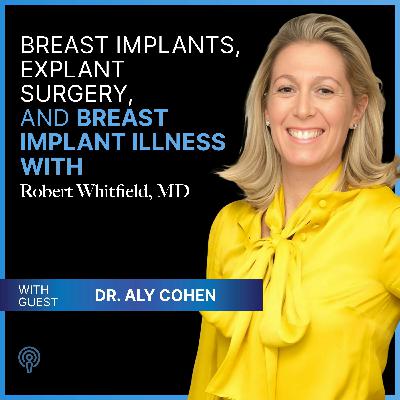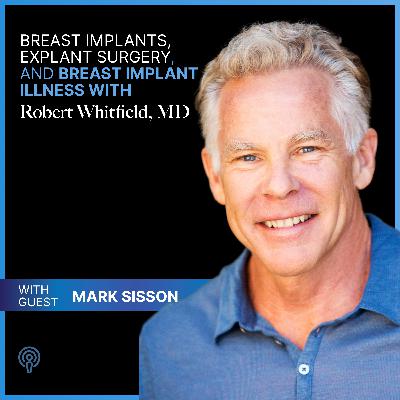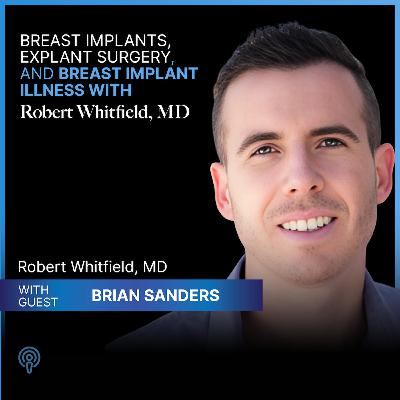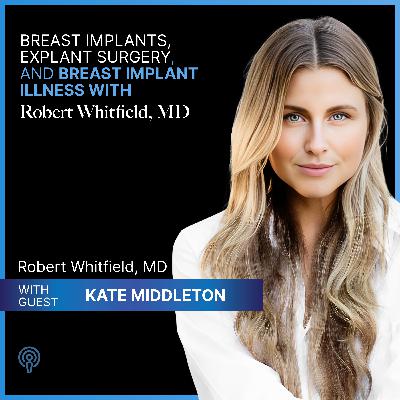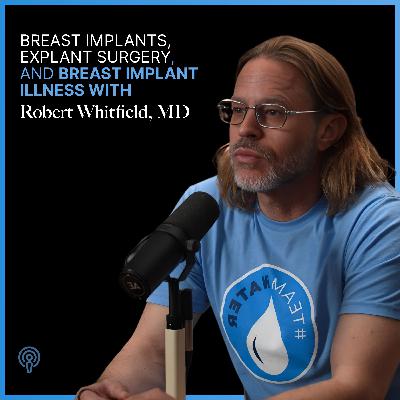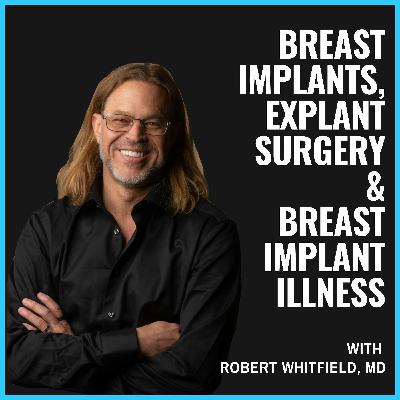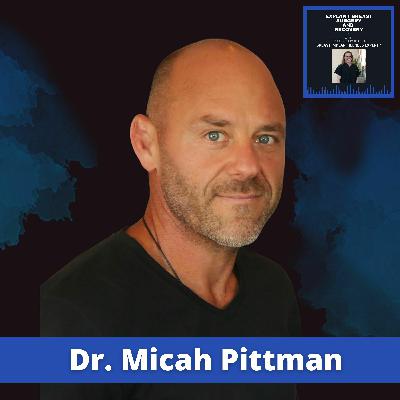Discover Breast Implants, Explant Surgery, and Breast Implant Illness with Robert Whitfield MD
Breast Implants, Explant Surgery, and Breast Implant Illness with Robert Whitfield MD

Breast Implants, Explant Surgery, and Breast Implant Illness with Robert Whitfield MD
Author: Robert Whitfield MD
Subscribed: 14Played: 244Subscribe
Share
© 2025 ©2024
Description
Welcome to the Breast Implants, Explant Surgery, and Breast Implant Illness Podcast, where we dive deep into the world of breast implant illness and explant surgery with expert plastic surgeon Dr. Robert Whitfield. As a board-certified plastic surgeon with 1000's of breast explant surgeries under his belt, Dr. Whitfield brings a wealth of knowledge and experience to the conversation.
Through candid interviews with patients, fellow surgeons, and other experts in the field, Dr. Whitfield explores the many facets of breast implant illness, including its symptoms, diagnosis, and treatment options. He also delves into the controversial topic of breast implant-associated anaplastic large cell lymphoma (BIA-ALCL) and what patients need to know about the risks associated with breast implants.
If you're considering breast explant surgery, struggling with breast implant illness symptoms, or simply looking for more information about this important topic, then the Breast Implant Illness Podcast is the perfect resource for you. Join us for thought-provoking discussions and expert insights that will help you make informed decisions about your health and well-being.
Through candid interviews with patients, fellow surgeons, and other experts in the field, Dr. Whitfield explores the many facets of breast implant illness, including its symptoms, diagnosis, and treatment options. He also delves into the controversial topic of breast implant-associated anaplastic large cell lymphoma (BIA-ALCL) and what patients need to know about the risks associated with breast implants.
If you're considering breast explant surgery, struggling with breast implant illness symptoms, or simply looking for more information about this important topic, then the Breast Implant Illness Podcast is the perfect resource for you. Join us for thought-provoking discussions and expert insights that will help you make informed decisions about your health and well-being.
142 Episodes
Reverse
Rheumatologist and environmental health expert Dr. Aly Cohen reveals a shocking truth: we're all toxic until proven otherwise. From the outdated 1974 Safe Drinking Water Act to the 10,000+ untested chemicals in our food supply, she explains why our bodies are fighting an uphill battle against chronic inflammation. But here's the reality—you don't need to wait for government regulation to start making changes that matter. Dr. Cohen walks through high-yield, actionable changes anyone can make: reverse osmosis water filtration that's cheaper than you think, frozen USDA organic foods that democratize nutrition, and simple swaps that cut chemical exposure without breaking the bank. You'll walk away understanding that your immune system isn't broken—it's just overwhelmed—and you have way more control than you realize.
IN THIS EPISODE WE’LL:
Discover when to test and when to act—Dr. Cohen explains why everyone's toxic until proven otherwise, and which changes matter most right now
Learn the one federal regulation that actually protects your food and how frozen USDA organics give you pesticide-free nutrition at a fraction of the cost
Break down why your tap water is likely contaminated regardless of where you live, and how a $400 reverse osmosis system can save you money compared to carbon filters
Expose how dust in your home concentrates chemicals from flame retardants, fragrances, and everyday products—plus the simple cleaning methods that actually work
Transform your approach to inflammation by understanding how everyday chemical exposures mimic hormones, disrupt immune signaling, and drive everything from breast implant illness to autoimmune disease
Let’s Connect
Podcast: https://podcasts.apple.com/gb/podcast/breast-implant-illness/id1678143554
Spotify: https://open.spotify.com/show/1SPDripbluZKYsC0rwrBdb?si=23ea2cd9f6734667
TikTok: https://www.tiktok.com/@drrobertwhitfield?t=8oQyjO25X5i&r=1
IG: https://www.instagram.com/breastimplantillnessexpert/
FB: https://www.facebook.com/DrRobertWhitfield
Linkedin: https://www.linkedin.com/in/dr-robert-whitfield-md-50775b10/
X: https://x.com/rob_whitfieldmd
Read this article - https://www.breastcancer.org/treatment/surgery/breast-reconstruction/types/implant-reconstruction/illness/breast-implant-illness
Shop: https://drrobssolutions.com
SHARP: https://www.harp.health
NVISN Labs - https://nvisnlabs.com/
Get access to Dr. Rob's Favorite Products below:
Danger Coffee - Use our link for mold free coffee - https://dangercoffee.com/pages/mold-free-coffee?ref=ztvhyjg
JASPR Air Purifier - Use code DRROB for the Jaspr Air Purifier - https://jaspr.co/
Echo Water - Get high quality water with our code DRROB10 - https://echowater.com/
BallancerPro - Use code DRROBVIP for the world's leader in lymphatic drainage technology - https://ballancerpro.com
Ultrahuman - Use code WHITFIELD10 for the most accurate wearable - https://www.ultrahuman.com/ring/buy/us/?affiliateCode=drwhitfield
Here's the reality—most people over 60 are walking around in shoes that are slowly destroying their feet, and they don't even know it. Mark Sisson joins me to explain how thick, cushioned, elevated shoes cut off the critical feedback loop between your feet and your brain, leading to weakened arches, lost balance, and eventually those devastating falls that change everything. We dive deep into why foot health is the lowest hanging fruit in longevity right now, how your big toe literally connects to your glute activation, and why the walking you do after surgery (or any day) matters more than you think. Mark shares insights from taking 35 first-time PELUVA wearers on a five-mile hike—nobody got blisters, and everyone felt the difference. If you're serious about staying strong, mobile, and independent as you age, this conversation will change how you think about every step you take.
IN THIS EPISODE WE'LL:
* Discover why conventional cushioned shoes are weakening your feet and compromising your entire kinetic chain—from your arches to your hips to your lower back
* Break through the myth that more cushioning equals more comfort, and learn how ground feel and toe splay are actually the keys to pain-free movement and injury prevention
* Transform your understanding of the big toe as the anchor of your entire lower body, directly wired to your glutes and essential for strength, balance, and preventing falls
* Explore why walking in community isn't just nice to have—it's a longevity strategy that combines movement, mental health, and meaningful connection in one simple practice
* Reclaim foot strength and resilience through barefoot training and minimalist footwear, protecting yourself from the frailty, osteoporosis, and devastating falls that derail so many people as they age
Let’s Connect
Podcast: https://podcasts.apple.com/gb/podcast/breast-implant-illness/id1678143554
Spotify: https://open.spotify.com/show/1SPDripbluZKYsC0rwrBdb?si=23ea2cd9f6734667
TikTok: https://www.tiktok.com/@drrobertwhitfield?t=8oQyjO25X5i&r=1
IG: https://www.instagram.com/breastimplantillnessexpert/
FB: https://www.facebook.com/DrRobertWhitfield
Linkedin: https://www.linkedin.com/in/dr-robert-whitfield-md-50775b10/
X: https://x.com/rob_whitfieldmd
Read this article - https://www.breastcancer.org/treatment/surgery/breast-reconstruction/types/implant-reconstruction/illness/breast-implant-illness
Shop: https://drrobssolutions.com
SHARP: https://www.harp.health
NVISN Labs - https://nvisnlabs.com/
Get access to Dr. Rob's Favorite Products below:
Danger Coffee - Use our link for mold free coffee - https://dangercoffee.com/pages/mold-free-coffee?ref=ztvhyjg
JASPR Air Purifier - Use code DRROB for the Jaspr Air Purifier - https://jaspr.co/
Echo Water - Get high quality water with our code DRROB10 - https://echowater.com/
BallancerPro - Use code DRROBVIP for the world's leader in lymphatic drainage technology - https://ballancerpro.com
Ultrahuman - Use code WHITFIELD10 for the most accurate wearable - https://www.ultrahuman.com/ring/buy/us/?affiliateCode=drwhitfield
Today’s episode highlights breast health concerns and educates women to make informed choices, as Dr. Robert Whitfield sits down with Dr. Alan Gonzalez, a fellow expert in plastic surgery. They break down what BII is, talk through common symptoms, and dive into complications like capsular contracture and even rare cases of lymphoma. The doctors walk listeners through the different surgical options for removing implants, including total capsulectomy, and discuss alternatives such as fat transfer for those considering a different look after explantation. They don’t shy away from discussing the emotional and physical challenges that can come with implant removal, and the conversation is one all women need to hear.
Bio: Dr. Alan Gonzalez
Dr. Alan González is a leading plastic surgeon in Colombia and Latin America, with over 25 years of experience and more than 20,000 aesthetic and reconstructive procedures performed. Known for combining cutting-edge surgical techniques with a focus on minimal scarring and fast recovery, he is dedicated to enhancing patient well-being through thoughtful, results-driven care. Dr. González is also a global speaker, researcher, and media contributor, and currently leads multidisciplinary research on the link between breast implants and ASIA syndrome. He is affiliated with several international surgical societies and serves as the scientific director of Care Me 360 Institute. (https://careme360.com/)
Learn more about Dr. González at dralangonzalez.com (https://dralangonzalez.com/)and connect with him on Instagram (https://www.instagram.com/dralangonzalez/) or LinkedIn (https://www.linkedin.com/in/alan-gonzalez-md/).
Show Highlights:
Dr. Gonzalez’s Background & Early Experience (00:01:09) Dr. Gonzalez shares his medical background, early views on implants, and initial belief in their safety.
Recognition of Implant Complications (00:04:25) *Discovering complications like lymphoma, chronic inflammation, and the shift in understanding implant risks
*Capsular Contracture & Surgical Approaches (00:10:11) *Capsular contracture, historical surgical practices, and the evolution of implant placement techniques
*Patient Symptoms & Chronic Inflammation (00:14:11) Normalization of symptoms, and the importance of recognizing chronic inflammation from implants
Capsulectomy Techniques & Cancer Concerns (00:17:26) Debate on total vs. en bloc capsulectomy, surgical safety, and handling abnormal capsule findings
Case Study: Lymphoma & Pathology Challenges (00:19:53) Dr. Whitfield shares a case of rare lymphoma, challenges in diagnosis, and the importance of surgical expertise
Patient Education & Informed Choices (00:25:47) Educating patients, the need for transparency, and the importance of understanding all surgical options
*Alternatives to Implants: Fat Transfer & Lifts (00:27:20) *Non-implant options like fat transfer and breast lifts, and the importance of individualized patient care
*Surgeon Expertise & Surgical Evolution (00:44:07) *Importance of expert surgeons, reconstructive techniques without implants, and the evolution of breast surgery
Links and Resources
Let’s Connect
Podcast: https://podcasts.apple.com/gb/podcast/breast-implant-illness/id1678143554
Spotify: https://open.spotify.com/show/1SPDripbluZKYsC0rwrBdb?si=23ea2cd9f6734667
TikTok: https://www.tiktok.com/@drrobertwhitfield?t=8oQyjO25X5i&r=1
IG: https://www.instagram.com/breastimplantillnessexpert/
FB: https://www.facebook.com/DrRobertWhitfield
Linkedin: https://www.linkedin.com/in/dr-robert-whitfield-md-50775b10/
X: https://x.com/rob_whitfieldmd
Read this article - https://www.breastcancer.org/treatment/surgery/breast-reconstruction/types/implant-reconstruction/illness/breast-implant-illness
Shop: https://drrobssolutions.com
SHARP: https://www.harp.health
NVISN Labs - https://nvisnlabs.com/
Get access to Dr. Rob's Favorite Products below:
Danger Coffee - Use our link for mold free coffee - https://dangercoffee.com/pages/mold-free-coffee?ref=ztvhyjg
JASPR Air Purifier - Use code DRROB for the Jaspr Air Purifier - https://jaspr.co/
Echo Water - Get high quality water with our code DRROB10 - https://echowater.com/
BallancerPro - Use code DRROBVIP for the world's leader in lymphatic drainage technology - https://ballancerpro.com
Ultrahuman - Use code WHITFIELD10 for the most accurate wearable - https://www.ultrahuman.com/ring/buy/us/?affiliateCode=drwhitfield
Ready to take charge of your health and feel your best? Today, Dr. Robert Whitfield speaks with filmmaker Brian Sanders to discuss how nutrition and smart food choices play a significant role in our overall health. Dr. Whitfield talks about what he’s learned from helping patients recover from breast implant illness, while Brian shares his own story of turning his health around by changing his diet. They both emphasize the perks of eating whole foods, getting enough protein, and cutting back on processed stuff. You’ll also hear some down-to-earth tips for eating healthy on a budget and why making lifestyle changes really matters. If you’re ready to turn your health around, tune in!
Bio: Brian Sanders
Brian Sanders is the filmmaker behind the Food Lies documentary, host of the top 5 nutrition podcast Peak Human, and an international speaker. He graduated from UCLA with a degree in Mechanical Engineering, and he’s the founder of Sapien Center, a popular health club in Austin. He also owns the grass-fed meat & beef tallow body care company, Nose to Tail.
https://www.indiegogo.com/projects/food-lies-post#/https://www.indiegogo.com/projects/food-lies-post#/
https://www.peak-human.com/https://www.peak-human.com/
http://sapiencenter.com/ (http://sapiencenter.com/)
https://nosetotail.org/ (https://nosetotail.org/)
Show Highlights:
Challenges in Changing Habits (00:04:00) The difficulty of changing unhealthy habits, especially for families and children
Enjoyable & Sustainable Healthy Eating (00:08:21) *How healthy eating can be enjoyable and sustainable
*Sugar Addiction & Satiety (00:13:36) Sugar addiction and satiety
Processed vs. Ultra-Processed Foods (00:17:33) Ultra-processed foods and their negative health impacts
Food Processing Categories (00:19:48) Three food categories: whole foods, traditionally processed, and industrially processed foods
Movement & Walking as Essential (00:24:29) *Daily movement and walking for metabolic health
*Protein Focus & Adaptability When Traveling (00:30:09) *Tips for maintaining a protein-focused diet while traveling
*Stepping Down from Unhealthy Snacks (00:32:04) Strategies for transitioning from unhealthy snacks, like chips, to better alternatives
Protein for Healing & Patient Care (00:38:28) Dr. Whitfield discusses the necessity of protein for healing, especially in surgical patients
Affordable Healthy Eating & Cooking Tips (00:40:28) Advice on sourcing affordable protein, simple cooking methods, and prioritizing unprocessed foods
Links and Resources
Let’s Connect
Podcast: https://podcasts.apple.com/gb/podcast/breast-implant-illness/id1678143554
Spotify: https://open.spotify.com/show/1SPDripbluZKYsC0rwrBdb?si=23ea2cd9f6734667
TikTok: https://www.tiktok.com/@drrobertwhitfield?t=8oQyjO25X5i&r=1
IG: https://www.instagram.com/breastimplantillnessexpert/
FB: https://www.facebook.com/DrRobertWhitfield
Linkedin: https://www.linkedin.com/in/dr-robert-whitfield-md-50775b10/
X: https://x.com/rob_whitfieldmd
Read this article - https://www.breastcancer.org/treatment/surgery/breast-reconstruction/types/implant-reconstruction/illness/breast-implant-illness
Shop: https://drrobssolutions.com
SHARP: https://www.harp.health
NVISN Labs - https://nvisnlabs.com/
Get access to Dr. Rob's Favorite Products below:
Danger Coffee - Use our link for mold free coffee - https://dangercoffee.com/pages/mold-free-coffee?ref=ztvhyjg
JASPR Air Purifier - Use code DRROB for the Jaspr Air Purifier - https://jaspr.co/
Echo Water - Get high quality water with our code DRROB10 - https://echowater.com/
BallancerPro - Use code DRROBVIP for the world's leader in lymphatic drainage technology - https://ballancerpro.com
Ultrahuman - Use code WHITFIELD10 for the most accurate wearable - https://www.ultrahuman.com/ring/buy/us/?affiliateCode=drwhitfield
In this episode, Dr. Robert Whitfield speaks with Kate Middleton, better known as KB, a toxic-free lifestyle advisor and host of Toxic Free with KB. Her personal experience with autoimmune issues, mold exposure, and stress-related burnout shaped her commitment to helping others reduce toxic load and live more intentionally.
Dr. Whitfield and KB discuss the mental strain of toxic perfectionism, the overlooked impact of decision fatigue, and how choosing simplicity can support long-term balance. They explore the role of intuition in wellness decisions, how kb reframed toxic relationships, and why incremental progress often matters more than drastic change.
KB also shares her lived experience with Raynaud’s and offers practical strategies for managing daily exposures through small, actionable habits.
This conversation is a grounded reminder that reducing toxins is not about perfection. It is about saying no, tuning in, and making sustainable, informed choices.
Growing up in Kansas City and identifying hidden toxic exposures
Learning to recognize emotional and relational toxicity
Why education tools like EWG and Yuka help make informed choices
Using grounding, nature, and intuition to simplify wellness
Personal insights on Raynaud’s and managing chronic conditions
The importance of boundaries and moving away from people-pleasing
Everyday strategies to support detoxification pathways
"You don’t have to overhaul everything at once. It’s about small shifts that make sense for your life." - KB
TIMESTAMPS
07:50 - Early exposures, chronic illness, and resilience
24:50 - Tools for better choices: Yuka, EWG, and education
38:28 - Toxic relationships and work environments
48:17 - Grounding, nature, and the power of simplicity
1:08:36 - Saying no, boundaries, and people-pleasing
1:15:00 - Final thoughts and how to connect with KB
Links and Resources
Let’s Connect
Podcast: https://podcasts.apple.com/gb/podcast/breast-implant-illness/id1678143554
Spotify: https://open.spotify.com/show/1SPDripbluZKYsC0rwrBdb?si=23ea2cd9f6734667
TikTok: https://www.tiktok.com/@drrobertwhitfield?t=8oQyjO25X5i&r=1
IG: https://www.instagram.com/breastimplantillnessexpert/
FB: https://www.facebook.com/DrRobertWhitfield
Linkedin: https://www.linkedin.com/in/dr-robert-whitfield-md-50775b10/
X: https://x.com/rob_whitfieldmd
Read this article - https://www.breastcancer.org/treatment/surgery/breast-reconstruction/types/implant-reconstruction/illness/breast-implant-illness
Shop: https://drrobssolutions.com
SHARP: https://www.harp.health
NVISN Labs - https://nvisnlabs.com/
Get access to Dr. Rob's Favorite Products below:
Danger Coffee - Use our link for mold free coffee - https://dangercoffee.com/pages/mold-free-coffee?ref=ztvhyjg
JASPR Air Purifier - Use code DRROB for the Jaspr Air Purifier - https://jaspr.co/
Echo Water - Get high quality water with our code DRROB10 - https://echowater.com/
BallancerPro - Use code DRROBVIP for the world's leader in lymphatic drainage technology - https://ballancerpro.com
Ultrahuman - Use code WHITFIELD10 for the most accurate wearable - https://www.ultrahuman.com/ring/buy/us/?affiliateCode=drwhitfield
Dr. Robert Whitfield speaks with Anu Simh, a board-certified functional coach, founder of Nine Arms Wellness, and author of Flourish From Within: Feed Your Gut for Lifelong Health. Their conversation focuses on practical strategies to support the microbiome, stabilize metabolism, and approach GLP-1 medications with long-term outcomes in mind.
Anu Simh shares her approach to helping women restore gut function, simplify food choices, and create sustainable habits that last. She also discusses her work training other coaches and advocating for women in underserved communities.
Topics include fiber variety, the role of environmental exposures like plastics and additives, and how coaching can promote both internal balance and external integrity without relying on restrictive or short-term methods.
This episode offers a realistic, science-informed discussion for listeners seeking steady, sustainable progress.
SHOW HIGHLIGHTS:
Meet Anu: coach, educator, and author of Flourish From Within
Microbiome 101 for real people: what diversity and resilience mean in practice
Fiber famine and why plant diversity matters more than perfection
Healthy fats, polyphenols, and functional foods that support short chain fatty acids
The antibiotic habit: collateral damage to immunity, motility, and metabolism
Travel gut problems and terrain building before and after the trip
Plastics, xenoestrogens, and why labels matter for weight maintenance
GLP-1s, rapid weight loss, and unintended effects on face fat and skin
Practical coaching for sustainability: keep it simple, consistent, and human
TIMESTAMPS
0:00 Welcome and Anu’s backstory
8:58 *Microbiome 101: microbes, symbiosis, and why it matters
*11:22 What a healthy microbiome really means: resilience and diversity
19:11 Healthy fats, polyphenols, and short chain fatty acids
29:55 Terrain building over bug hunting: how to make the gut more resilient
35:35 *Estrogen recycling, the estrobolome, plastics, and preservatives
*47:25 Gut motility and gastric emptying issues
*52:34 *GLP-1s, real-world side effects, and sustainable coaching
Links and Resources
Let’s Connect
Podcast: https://podcasts.apple.com/gb/podcast/breast-implant-illness/id1678143554
Spotify: https://open.spotify.com/show/1SPDripbluZKYsC0rwrBdb?si=23ea2cd9f6734667
TikTok: https://www.tiktok.com/@drrobertwhitfield?t=8oQyjO25X5i&r=1
IG: https://www.instagram.com/breastimplantillnessexpert/
FB: https://www.facebook.com/DrRobertWhitfield
Linkedin: https://www.linkedin.com/in/dr-robert-whitfield-md-50775b10/
X: https://x.com/rob_whitfieldmd
Read this article - https://www.breastcancer.org/treatment/surgery/breast-reconstruction/types/implant-reconstruction/illness/breast-implant-illness
Shop: https://drrobssolutions.com
SHARP: https://www.harp.health
NVISN Labs - https://nvisnlabs.com/
Get access to Dr. Rob's Favorite Products below:
Danger Coffee - Use our link for mold free coffee - https://dangercoffee.com/pages/mold-free-coffee?ref=ztvhyjg
JASPR Air Purifier - Use code DRROB for the Jaspr Air Purifier - https://jaspr.co/
Echo Water - Get high quality water with our code DRROB10 - https://echowater.com/
BallancerPro - Use code DRROBVIP for the world's leader in lymphatic drainage technology - https://ballancerpro.com
Ultrahuman - Use code WHITFIELD10 for the most accurate wearable - https://www.ultrahuman.com/ring/buy/us/?affiliateCode=drwhitfield
Dr. Robert Whitfield speaks with Natalie Jill about her 33-year experience with breast implants, sharing the ups and downs, health issues, and emotional struggles she’s faced along the way. They discuss the medical risks, such as capsular contracture and bacterial contamination, and emphasize the importance of being informed. They really stress the value of awareness, making thoughtful decisions, and taking a holistic approach to health, especially for women who are thinking about getting implants or already have them. Tune in to hear about putting your well-being first and not hesitating to reach out for support if you think you may be dealing with breast implant-related health concerns.
Bio: Natalie Jill
Natalie Jill is a Midlife Expert who helps women simplify complicated health topics and redefine healthy aging. With a top-rated podcast “Midlife Conversations”, two best-selling Fat Loss Books that sold out in stores everywhere, and numerous TV appearances on shows like “The Doctors”, she built a high 7-figure Fat Loss business that transformed over 250,000 women's bodies and health. Over 50 years old herself, she is changing conversations around age, potential, and possibility! In addition to her Midlife Fat Loss Business, she helps founders, executives, and CEOs skyrocket their sales and find more money through upleveling their vision, dialing in their messaging, expanding their brand online, and fixing their sales and webinar conversion process. She used the exact methods she teaches to grow her globally recognized fat loss and fitness brand with well over 3 million social media followers worldwide, two best-selling books, a top-ranked podcast, and recognition from Forbes and Greatist several years running as one of the top health and wellness influencers in the world. Download Your Post-Surgical Recovery Guide (https://getrapidrecovery.com/)and Download Your Age Optimizing Supplement Guide (https://ageoptimizer.com)
Show Highlights:
Natalie’s 33-Year Breast Implant Journey Begins (00:02:12) Natalie describes getting implants at 19, her initial motivations, and the start of her long history with complications.
First Major Complication: Silicone Rupture and Autoimmune Issues (00:03:57) The first implant rupture, the resulting health issues, and the connection to her autoimmune diagnosis
Recurring Capsular Contracture and Surgical Interventions (00:04:06) *Repeated capsular contracture, multiple surgeries, and lack of awareness about bacterial contamination
*Blood Sugar Dysregulation and Parasite Protocol (00:12:13) Severe blood sugar issues, gut health, and a parasite protocol
Discovery of Ruptured Gummy Bear Implant (00:14:24) *Mammogram reveals a ruptured implant, leading to further testing and the decision to remove it
*Cultural Pressures and Body Image Trends (00:25:39) *Natalie and Dr. Whitfield reflect on changing beauty standards, media influence, and societal pressures on women.
*Genetics, Detoxification, and Environmental Toxins (00:31:19) Dr. Whitfield discusses genetic factors in detoxification, environmental toxins, and comprehensive patient care.
Prioritizing Health Interventions and Toxin Removal (00:35:00) Prioritizing health interventions, amalgam removal, and the importance of detox pathways
Links and Resources
Let’s Connect
Podcast: https://podcasts.apple.com/gb/podcast/breast-implant-illness/id1678143554
Spotify: https://open.spotify.com/show/1SPDripbluZKYsC0rwrBdb?si=23ea2cd9f6734667
TikTok: https://www.tiktok.com/@drrobertwhitfield?t=8oQyjO25X5i&r=1
IG: https://www.instagram.com/breastimplantillnessexpert/
FB: https://www.facebook.com/DrRobertWhitfield
Linkedin: https://www.linkedin.com/in/dr-robert-whitfield-md-50775b10/
X: https://x.com/rob_whitfieldmd
Read this article - https://www.breastcancer.org/treatment/surgery/breast-reconstruction/types/implant-reconstruction/illness/breast-implant-illness
Shop: https://drrobssolutions.com
SHARP: https://www.harp.health
NVISN Labs - https://nvisnlabs.com/
Get access to Dr. Rob's Favorite Products below:
Danger Coffee - Use our link for mold free coffee - https://dangercoffee.com/pages/mold-free-coffee?ref=ztvhyjg
JASPR Air Purifier - Use code DRROB for the Jaspr Air Purifier - https://jaspr.co/
Echo Water - Get high quality water with our code DRROB10 - https://echowater.com/
BallancerPro - Use code DRROBVIP for the world's leader in lymphatic drainage technology - https://ballancerpro.com
Ultrahuman - Use code WHITFIELD10 for the most accurate wearable - https://www.ultrahuman.com/ring/buy/us/?affiliateCode=drwhitfield
Today, Dr. Robert Whitfield speaks with Dr. Aimee Duffy, the founder of Carolina Integrative Medicine. They discuss Dr. Duffy’s path into functional and integrative medicine, highlighting the importance of hormonal health, nutrition, and lifestyle choices for overall wellness. Their conversation touches on common misconceptions about hormone therapy, the connection between cholesterol and hormones, and why preventative, holistic care matters. They emphasize the importance of patient education, resilience, and creative wellness strategies, encouraging listeners to take proactive steps toward long-term health and vitality. You’re not going to want to miss this conversation, so tune in!
Bio: Dr. Aimee Duffy
Dr. Aimee Duffy is a board-certified physician and founder of Carolina Integrative Medicine, specializing in functional and integrative healthcare. With over 20 years of medical experience, Dr. Duffy is dedicated to empowering individuals to regain their vitality and wellness by addressing the root causes of complex health challenges like hormonal imbalances, chronic fatigue, weight changes, and mood disorders.
A bestselling author of Normal Doesn’t Have Side Effects, Dr. Duffy combines her extensive knowledge of conventional medicine with holistic treatments to create personalized care plans that include nutrition, lifestyle adjustments, and hormone balancing. Known for her compassionate approach, she provides a supportive space where patients feel heard, understood, and guided throughout their health journeys.
CarolinaIntegrativeMedicine.com (http://www.carolinaintegrativemedicine.com/)
AimeeDuffyMD.com (http://www.aimeeduffymd.com/)
Show Highlights:
Impact of Hormones on Chronic Disease (00:06:54) Relationship between hormonal decline and increased risk of chronic diseases
Hormones, Surgery, and Recovery Efficiency (00:12:13) Role of hormonal balance in surgical outcomes and recovery
Integrative Approach to Health (00:14:03) Importance of nutrition, environment, and lifestyle in overall health and recovery
Patient Education & Foundational Wellness (00:18:59)Approach to patient education, wellness programs, and the multifactorial nature of health
Alcohol, Blood Sugar, and Hot Flashes (00:20:02) Lifestyle factors like alcohol and blood sugar, and how they affect symptoms and hormones
*Stress, Adrenals, and Hormonal Imbalance (00:23:15) *Chronic stress and how it affects cortisol, progesterone, and overall hormonal health
*Diet, Fasting, and Intentional Eating (00:28:59) *Fasting, intentional eating, and the impact of modern diets on health
*Proactive Anti-Aging & Longevity (00:47:37) *Proactive health measures for longevity and optimal aging, not just lifespan extension
Links and Resources
Let’s Connect
Podcast: https://podcasts.apple.com/gb/podcast/breast-implant-illness/id1678143554
Spotify: https://open.spotify.com/show/1SPDripbluZKYsC0rwrBdb?si=23ea2cd9f6734667
TikTok: https://www.tiktok.com/@drrobertwhitfield?t=8oQyjO25X5i&r=1
IG: https://www.instagram.com/breastimplantillnessexpert/
FB: https://www.facebook.com/DrRobertWhitfield
Linkedin: https://www.linkedin.com/in/dr-robert-whitfield-md-50775b10/
X: https://x.com/rob_whitfieldmd
Read this article - https://www.breastcancer.org/treatment/surgery/breast-reconstruction/types/implant-reconstruction/illness/breast-implant-illness
Shop: https://drrobssolutions.com
SHARP: https://www.harp.health
NVISN Labs - https://nvisnlabs.com/
Get access to Dr. Rob's Favorite Products below:
Danger Coffee - Use our link for mold free coffee - https://dangercoffee.com/pages/mold-free-coffee?ref=ztvhyjg
JASPR Air Purifier - Use code DRROB for the Jaspr Air Purifier - https://jaspr.co/
Echo Water - Get high quality water with our code DRROB10 - https://echowater.com/
BallancerPro - Use code DRROBVIP for the world's leader in lymphatic drainage technology - https://ballancerpro.com
Ultrahuman - Use code WHITFIELD10 for the most accurate wearable - https://www.ultrahuman.com/ring/buy/us/?affiliateCode=drwhitfield
Have you ever wondered if your body’s energy could be the missing link to true healing? Today, Dr. Robert Whitfield speaks with Harry Massey, a true trailblazer in bioenergetics. Harry’s story is nothing short of incredible; from being bedridden with a chronic illness to inventing cutting-edge, energy-based health technologies that are changing lives. We delve into the fascinating science of bioenergetics, examining why your emotional well-being is just as crucial as your physical health. Tune in to hear more!
Bio: Harry Massey
Harry Massey is a globally recognized expert in bioenergetics, the science that examines the energy in living systems. As the founder of NES Health, XPO Health, and Energy4Life, he has developed groundbreaking technologies, including the FDA-cleared miHealth device, infoceuticals, and the Bioenergetic WellNES System, to help people restore their energy, health, and vitality. Harry is also the producer of the award-winning documentary "The Living Matrix" and the creator of the GIST Process, a system for mastering energy to transform one's life. Through his Institute of Bioenergetics, he continues to advance research and public education in partnership with UC San Diego.
HarryMassey.com (http://HarryMassey.com)
Energy 4 Life (https://www.e4l.com/)
E4l.com\rob (https://www.e4l.com/rob)
Facebook (https://www.facebook.com/harry.massey1/?kuid=1efb244d-e226-437d-988c-0c7ea1e208d7-1750814129&kref=https%3A%2F%2Fwww.harrymassey.com%2Fwho-is-harry-massey%2F)
Instagram (https://www.instagram.com/harrymasseyofficial/?kuid=1efb244d-e226-437d-988c-0c7ea1e208d7-1750814129&kref=https%3A%2F%2Fwww.harrymassey.com%2Fwho-is-harry-massey%2F)
YouTube (https://www.youtube.com/channel/UCt-AsCVcd6LIOtTTOPb6iSQ)
Show Highlights:
Harry’s Illness and Journey to Bioenergetics (00:02:22) Harry recounts his climbing accident, subsequent illness, and years of being bedridden.
Bioenergetics vs. Biochemistry (00:07:58) Discussion on whether healing focuses on mitochondria, and the need to address all body systems, not just one.
Physics and Biophysics in Healing (00:10:18) Transition from traditional chemistry-based views to physics and field-based understanding of body control systems
Suppression of Energy Medicine (00:15:01) Historical context on the suppression of energy medicine and the dominance of pharmaceuticals
Principles of Bioenergetics & Body Battery (00:18:52) Concept of the body battery, cellular energy, and strategies for energy regeneration and efficiency.
Emotional States and Disease (00:22:25) How negative emotions drain energy and contribute to disease, and how their wearables address this
Mindset and Healing (00:24:46) Discussion on the importance of mindset, emotional support, and the role of AI and journaling
Pain Management Technologies (00:29:33) Introduction of the MIHealth device, its mechanisms for pain relief, and the use of red light therapy
Links and Resources
Podcast: https://podcasts.apple.com/gb/podcast/breast-implant-illness/id1678143554
Spotify: https://open.spotify.com/show/1SPDripbluZKYsC0rwrBdb?si=23ea2cd9f6734667
TikTok: https://www.tiktok.com/@drrobertwhitfield?t=8oQyjO25X5i&r=1
IG: https://www.instagram.com/breastimplantillnessexpert/
FB: https://www.facebook.com/DrRobertWhitfield
Linkedin: https://www.linkedin.com/in/dr-robert-whitfield-md-50775b10/
X: https://x.com/rob_whitfieldmd
Read this article: https://www.breastcancer.org/treatment/surgery/breast-reconstruction/types/implant-reconstruction/illness/breast-implant-illness
Shop: https://drrobssolutions.com
SHARP: https://www.harp.health
NVISN Labs - https://nvisnlabs.com/
Get access to Dr. Rob's Favorite Products below:
Danger Coffee - Use our link for mold free coffee - https://dangercoffee.com/pages/mold-free-coffee?ref=ztvhyjg
JASPR Air Purifier - Use code DRROB for the Jaspr Air Purifier - https://jaspr.co/
Echo Water - Get high quality water with our code DRROB10 - https://echowater.com/
BallancerPro - Use code DRROBVIP for the world's leader in lymphatic drainage technology - https://ballancerpro.com
Ultrahuman - Use code WHITFIELD10 for the most accurate wearable - https://www.ultrahuman.com/ring/buy/us/?affiliateCode=drwhitfield
Ready to get real about breast augmentation? In this episode, we’re diving deep into the world of cosmetic surgery with a no-holds-barred conversation you won’t want to miss! Today, Dr. Robert Whitfield speaks with a patient, Kathy Dixon, who’s here to share her personal journey. Kathy opens up about how her cultural background shaped her decisions, her struggles with breast implant illness, and what led her to choose explant surgery. Tune in to hear so much more!
Kathy’s Business, Oh Yes Communications (https://www.ohyescommunications.com/author/kathy/)
Show Highlights:
Kathy’s Cultural Influences & Decision for Augmentation (00:02:45) *Kathy discusses her Colombian heritage, body image, and initial decision to pursue breast augmentation.
*Cultural Trends in Plastic Surgery (00:08:21) South American vs. U.S. beauty standards, Brazilian butt lifts, and safety concerns.
Fat Transfer Misconceptions & Technical Details (00:09:11) Differences between fat transfer to buttocks, face, and breasts, and addresses misconceptions
Kathy’s Surgical Journey & Onset of Symptoms (00:16:29) *Kathy recounts her initial surgery, complications, and the gradual onset of physical and emotional symptoms.
*Medical Dismissal & Search for Answers (00:18:36) Being dismissed by doctors, pursuing hormone testing, and discovering breast implant illness
Testing, Mold, and Mycotoxins (00:20:34) High mold count; surgeon discusses PCR testing, bacterial contamination, and importance of thorough pathology
Challenges in Women’s Health & Medical Gaslighting (00:28:00) Lack of support for women, medical gaslighting, and inappropriate reliance on birth control for hormone issues
Mold, Detoxification, and Environmental Factors (00:33:37) *Environmental and dietary sources of mold, detox challenges, and lifestyle changes
*Post-Surgery Recovery & Lifestyle Adjustments (00:44:11) *Recovery goals, physical therapy, emotional healing, and the importance of support systems
*Support Systems & Patient Experience (00:48:25) Importance of family support, patient education, and realistic expectations for recovery
Links and Resources
Let’s Connect
Podcast: https://podcasts.apple.com/gb/podcast/breast-implant-illness/id1678143554
Spotify: https://open.spotify.com/show/1SPDripbluZKYsC0rwrBdb?si=23ea2cd9f6734667
TikTok: https://www.tiktok.com/@drrobertwhitfield?t=8oQyjO25X5i&r=1
IG: https://www.instagram.com/breastimplantillnessexpert/
FB: https://www.facebook.com/DrRobertWhitfield
Linkedin: https://www.linkedin.com/in/dr-robert-whitfield-md-50775b10/
X: https://x.com/rob_whitfieldmd
Read this article - https://www.breastcancer.org/treatment/surgery/breast-reconstruction/types/implant-reconstruction/illness/breast-implant-illness
Shop: https://drrobssolutions.com
SHARP: https://www.harp.health
NVISN Labs - https://nvisnlabs.com/
Get access to Dr. Rob's Favorite Products below:
Danger Coffee - Use our link for mold free coffee - https://dangercoffee.com/pages/mold-free-coffee?ref=ztvhyjg
JASPR Air Purifier - Use code DRROB for the Jaspr Air Purifier - https://jaspr.co/
Echo Water - Get high quality water with our code DRROB10 - https://echowater.com/
BallancerPro - Use code DRROBVIP for the world's leader in lymphatic drainage technology - https://ballancerpro.com
Ultrahuman - Use code WHITFIELD10 for the most accurate wearable - https://www.ultrahuman.com/ring/buy/us/?affiliateCode=drwhitfield
This week, Dr. Robert Whitfield joins the global #TeamWater challenge with a focused episode on one of the most overlooked factors in healing: your water. From municipal toxins to hydrogen protocols, Dr. Robert breaks down how water impacts inflammation, recovery, detox, and long-term wellness.
Join #TeamWater! Go to teamwater.org (https://www.teamwater.org/) right now to donate and make a difference!
What you’ll learn:
Why plastic, PFAS, and endocrine disruptors hide in common water sources
What Dr. Robert uses to filter water in his home and practice
How hydrogen water reduces oxidative stress and improves sleep
Why hydration after surgery must include amino acids, not just electrolytes
How structured water supports the gut, the brain, and the lymphatic system
This isn’t just about hydration.
It’s about making your water therapeutic.
Chapters:
03:21 – The real problem with U.S. water systems
07:45 – What PFAS, plastics, and pharmaceuticals do to your body
10:30 – Dr. Robert’s home filtration setup (and what to avoid)
14:02 – Why hydrogen water reduces inflammation
17:44 – How water impacts the gut, the brain, and the lymphatic system
23:55 – Post-op hydration: amino acids vs. electrolytes
28:13 – The SHARP Method’s approach to hydration
Links and Resources
Let’s Connect
Podcast: https://podcasts.apple.com/gb/podcast/breast-implant-illness/id1678143554
Spotify: https://open.spotify.com/show/1SPDripbluZKYsC0rwrBdb?si=23ea2cd9f6734667
TikTok: https://www.tiktok.com/@drrobertwhitfield?t=8oQyjO25X5i&r=1
IG: https://www.instagram.com/breastimplantillnessexpert/
FB: https://www.facebook.com/DrRobertWhitfield
Linkedin: https://www.linkedin.com/in/dr-robert-whitfield-md-50775b10/
X: https://x.com/rob_whitfieldmd
Read this article - https://www.breastcancer.org/treatment/surgery/breast-reconstruction/types/implant-reconstruction/illness/breast-implant-illness
Shop: https://drrobssolutions.com
SHARP: https://www.harp.health
NVISN Labs - https://nvisnlabs.com/
Get access to Dr. Rob's Favorite Products below:
Danger Coffee - Use our link for mold free coffee - https://dangercoffee.com/pages/mold-free-coffee?ref=ztvhyjg
JASPR Air Purifier - Use code DRROB for the Jaspr Air Purifier - https://jaspr.co/
Echo Water - Get high quality water with our code DRROB10 - https://echowater.com/
BallancerPro - Use code DRROBVIP for the world's leader in lymphatic drainage technology - https://ballancerpro.com
Ultrahuman - Use code WHITFIELD10 for the most accurate wearable - https://www.ultrahuman.com/ring/buy/us/?affiliateCode=drwhitfield
Today, Dr. Robert Whitfield sits down for a chat with former race car driver, Danica Patrick. Danica opens up about what it was like to move to England at just 16 to chase her racing dreams, her personal experience with breast implants, and the health struggles she faced because of them. She and Dr. Whitfield discuss the road to recovery, the importance of self-care, and the need to truly listen to what your body is telling you. They also shine a light on Danica’s shift into entrepreneurship and stress how important it is to raise awareness and offer support for anyone dealing with breast implant illness and similar health challenges.
Bio: Danica Patrick
Danica Patrick is a trail-blazing former racecar driver who smashed motorsport records: first woman to lead laps & finish top-5 at the Indy 500, first female winner of a major North American open-wheel race, and first woman to claim a NASCAR Cup Series pole, capping her career with the 2018 “Danica Double” at Daytona 500 and Indy 500. Named to TIME’s “100 Most Influential People” and featured in a record 14 Super Bowl ads, Danica has since shifted gears into entrepreneurship. She owns Somnium Vineyard in Napa, expanded with Danica Rosé and the VOYANT home line, and hosts the bestselling book-turned-podcast Pretty Intense. Connect: @danicapatrick | @SomniumWine | @DanicaRoseWine.Danicapatrick.com (https://www.danicapatrick.com/)
Show Highlights:
Danica’s Move to England & Early Racing Career (00:01:13)
Moving to England at 16, adapting to a new environment, and early racing experiences.
*Decision to Get Breast Implants (00:08:37) *
Motivations for getting breast implants and Danica’s initial trust in their safety
*Onset and Progression of Health Issues (00:10:54) *
Gradual onset of symptoms and complications after getting implants
Heavy Metals, Detox, and Health Challenges (00:11:52)
Heavy metal toxicity, detox protocols, and the impact of diet and implants
*Diet, Recovery, and Symptom Awareness (00:14:14) *
Dietary habits, symptom awareness, and the journey to identifying breast implant illness
*Medical Workups and Explant Surgery (00:14:48) *
Medical workups, failed treatments, and eventual decision to explant in April 2022
*Thyroid Issues and Post-Explant Recovery (00:18:40) *
Thyroid medication, inflammation, and the body’s response after explant surgery
*Detoxification, Sweating, and Alternative Therapies (00:28:54) *
Sweating, detoxification, and alternative therapies like IBU and steam saunas
Links and Resources
Let’s Connect
Podcast: https://podcasts.apple.com/gb/podcast/breast-implant-illness/id1678143554
Spotify: https://open.spotify.com/show/1SPDripbluZKYsC0rwrBdb?si=23ea2cd9f6734667
TikTok: https://www.tiktok.com/@drrobertwhitfield?t=8oQyjO25X5i&r=1
IG: https://www.instagram.com/breastimplantillnessexpert/
FB: https://www.facebook.com/DrRobertWhitfield
Linkedin: https://www.linkedin.com/in/dr-robert-whitfield-md-50775b10/
X: https://x.com/rob_whitfieldmd
Read this article - https://www.breastcancer.org/treatment/surgery/breast-reconstruction/types/implant-reconstruction/illness/breast-implant-illness
Shop: https://drrobssolutions.com
SHARP: https://www.harp.health
NVISN Labs - https://nvisnlabs.com/
Get access to Dr. Rob's Favorite Products below:
Danger Coffee - Use our link for mold free coffee - https://dangercoffee.com/pages/mold-free-coffee?ref=ztvhyjg
JASPR Air Purifier - Use code DRROB for the Jaspr Air Purifier - https://jaspr.co/
Echo Water - Get high quality water with our code DRROB10 - https://echowater.com/
BallancerPro - Use code DRROBVIP for the world's leader in lymphatic drainage technology - https://ballancerpro.com
Ultrahuman - Use code WHITFIELD10 for the most accurate wearable - https://www.ultrahuman.com/ring/buy/us/?affiliateCode=drwhitfield
Many people struggling with chronic illness, fatigue, brain fog, or unexplained symptoms never find real answers because they’re not addressing the root cause: cellular toxicity.
In this episode, Dr. Robert Whitfield sits down with Dr. Daniel Pompa, a leading voice in cellular detox and functional medicine, to explore why so many people stay sick despite trying countless protocols. They break down how inflammation, toxic overload, and chemical exposure disrupt your body at the cellular level and what it actually takes to start healing.
Whether you’re dealing with hormonal imbalances, autoimmune symptoms, or post-explant recovery, this conversation is a must-listen for anyone interested in root-cause healing and natural detox strategies that work.
👉 Learn more about Dr. Pompa’s protocols and philosophy at: https://drpompa.com (https://drpompa.com)
Show Highlights:
Rising Awareness and FDA Testimony (00:06:10)
Dr. Robert discusses testifying before the FDA and the industry's lack of transparency about how many implants are sold and who is qualified to place them.
Symptoms, Autoimmunity & The Hidden Impact (00:8:00)
Many women present with chronic fatigue, brain fog, and autoimmune symptoms—often misdiagnosed—when bacterial contamination from implants is the real issue.
The Problem with Traditional Lab Testing (00:10:22)
Dr. Robert explains how traditional swab cultures miss low-level infections and why PCR testing is crucial for accurate diagnoses during explant surgery.
Biofilm and Immune Dysregulation (00:18:00)
The doctors break down how biofilms from staph and cutibacterium trigger macrophage changes and long-term immune system dysregulation.
Detoxing After Explant (00:25:20)
Dr. Pompa explains that true recovery after explant requires deep detox at the cellular level, especially for those with toxin overload or genetic detox challenges.
Hormone Resistance and Neurological Symptoms (00:33:00)
Heavy metals and biotoxins disrupt hormone signaling, thyroid function, and the brain’s control center, contributing to long-term dysfunction.
The Problem with Food and Seed Oils (00:45:10)
The doctors discuss how processed foods, seed oils, and glyphosate exposure create widespread cellular inflammation and contribute to chronic illness.
The Truth About Detox: It Takes Time (01:00:30)
The doctors wrap by emphasizing that detox is not a 10-day cleanse—true healing can take years, and begins by fixing the cell to get well.
Links and Resources
🎧 Listen to Dr. Rob’s Podcast:
Apple: Breast Implant Illness on Apple Podcasts (https://podcasts.apple.com/gb/podcast/breast-implant-illness/id1678143554)
Spotify: Breast Implant Illness on Spotify (https://open.spotify.com/show/1SPDripbluZKYsC0rwrBdb?si=23ea2cd9f6734667)
📱 Follow Dr. Rob:
TikTok @dr.robertwhitfieldmd (https://www.tiktok.com/@drrobertwhitfield?_t=8oQyjO25X5i&_r=1)
Instagram: @dr.robertwhitfield (https://www.instagram.com/dr.robertwhitfield/?hl=en)
Facebook: Dr. Robert Whitfield MD (https://www.facebook.com/DrRobertWhitfield/)
X (Twitter): @whitfieldmd (https://x.com/whitfieldmd/status/1878489700752646220)
📖 Educational Resource:
SHARP Protocol: HARP.Health (https://www.harp.health)
🛍️ Shop Dr. Rob’s Favorites:
Supplements: Dr. Rob's Solutions (https://drrobssolutions.com)
Lab Testing: NVISN Labs (https://nvisnlabs.com)
☕ Partner Products:
Danger Coffee (mold-free) (https://dangercoffee.com/pages/mold-free-coffee?ref=ztvhyjg)
JASPR Air Purifier — Use code DRROB (https://jaspr.co/)
Echo Water — Use code DRROB10 (https://ballancerpro.com)
BallancerPro — Use code DRROBVIP (https://ballancerpro.com)
Ultrahuman Ring — Use code WHITFIELD10 (https://www.ultrahuman.com/ring/buy/us/?affiliateCode=drwhitfield)
Behind the fascination with augmented breasts is a complex truth that involves a number of experiences, such as trauma and the necessity for explants or breast implant removal. While breast implants have provided benefits for many women, they have also been connected with major complications and traumatic experiences.
In today’s episode, we are joined by Candice Barley, a breast implant illness patient advocate, and by Dr. Amanda Savage Brown, the author of Busting Free: How to Liberate Yourself from the Quest for Better Breasts Before, During, and Long After Explant.
If you want to grab a copy of Dr. Brown’s book, you can visit her website through this link: https://amandasavagebrown.com/
Website - https://amandasavagebrown.com/ (https://amandasavagebrown.com/)
Show Highlights:
Why Write "Busting Free"? (00:03:22) Dr. Brown explains her motivation for writing her book and the unmet psychosocial needs of women with breast implants.
The Origin of the "Breast Rule Book" (00:06:56) Societal beliefs about breasts, how these beliefs form, and their impact on self-image
Individual Breast Rule Books & Social Pressures (00:13:38) How each woman’s experience is unique, and the role of peer and societal pressure in shaping self-worth
Psychological Flexibility & Adaptation (00:22:01) Psychological flexibility as it relates to patients and surgeons, emphasizing adaptability in care
Partner Considerations & Relationship Dynamics (00:26:42) Addressing the complexities of partner reactions to explant surgery and strategies for communication and support.
The Importance of Advocacy & Support (00:29:48) The value of patient advocacy and having supportive professionals during the explant journey
Will I Get Better? Addressing Patient Fears (00:37:48) Approach to treating inflammation and the holistic methods used in his practice
Tipping Points: Stress, Trauma, and Illness (00:39:30) Life stressors, trauma, and environmental exposures in triggering breast implant illness symptoms
The Real Challenge: Post-Surgical Recovery (00:44:17) Complexity of recovery after explant surgery and the need for ongoing support
Medical Gaslighting & Patient Validation (00:48:03) Emotional impact of being dismissed by doctors and the relief of being believed
Links and Resources
Podcast: https://podcasts.apple.com/gb/podcast/breast-implant-illness/id1678143554
Spotify: https://open.spotify.com/show/1SPDripbluZKYsC0rwrBdb?si=23ea2cd9f6734667
TikTok: https://www.tiktok.com/@drrobertwhitfield?t=8oQyjO25X5i&r=1
IG: https://www.instagram.com/breastimplantillnessexpert/
FB: https://www.facebook.com/DrRobertWhitfield
Linkedin: https://www.linkedin.com/in/dr-robert-whitfield-md-50775b10/
X: https://x.com/rob_whitfieldmd
Read this article - https://www.breastcancer.org/treatment/surgery/breast-reconstruction/types/implant-reconstruction/illness/breast-implant-illness
Shop: https://drrobssolutions.com
SHARP: https://www.harp.health
NVISN Labs - https://nvisnlabs.com/
Get access to Dr. Rob's Favorite Products below:
Danger Coffee - Use our link for mold free coffee - https://dangercoffee.com/pages/mold-free-coffee?ref=ztvhyjg
JASPR Air Purifier - Use code DRROB for the Jaspr Air Purifier - https://jaspr.co/
Echo Water - Get high quality water with our code DRROB10 - https://echowater.com/
BallancerPro - Use code DRROBVIP for the world's leader in lymphatic drainage technology - https://ballancerpro.com
Ultrahuman - Use code WHITFIELD10 for the most accurate wearable - https://www.ultrahuman.com/ring/buy/us/?affiliateCode=drwhitfield
Not every breast explant journey looks the same, but when you hear these stories over and over again, the similarities are remarkable. Today, Candice Barley shares her breast implant illness journey with Dr. Rob. Candice's story is one of hope and ultimately a return to health. If you are struggling with Breast Implant Illness, there is hope for you as well.
In our previous episodes, we’ve talked about how inflammation worsens the illness. That’s why we have to figure out whether or not there’s inflammation in the breast implants. So what we do is we work up all the factors that contribute to inflammation by testing through our Holistic Accelerated Recovery Program (HARP) to really prepare the patients and optimize them for surgery.
If you want to learn more about HARP, you can secure your seat through this link: https://harp.health/
Links and Resurces
Dr. Robert Whitfield’s Website (https://drrobssolutions.com/)
For any inquiries or concerns, feel free to connect with us on Instagram (@breastimplantillnessexpert).
https://www.instagram.com/drrobertwhitfield/
For more information on Virtual and In Person Consultations, we always answer our messenger personally:
https://www.drrobertwhitfield.com/contact/
Try the Echo Hydrogen Water Bottle (https://echowater.com/?oid=21&affid=720)
Code is DRROB10.
Let’s Connect...
Podcast: https://podcasts.apple.com/gb/podcast/breast-implant-illness/id1678143554
Spotify: https://open.spotify.com/show/1SPDripbluZKYsC0rwrBdb?si=23ea2cd9f6734667
TikTok: https://www.tiktok.com/@drrobertwhitfield?t=8oQyjO25X5i&r=1
IG: https://www.instagram.com/breastimplantillnessexpert/
FB: https://www.facebook.com/DrRobertWhitfield
Linkedin: https://www.linkedin.com/in/dr-robert-whitfield-md-50775b10/
X: https://x.com/rob_whitfieldmd
Read this article - https://www.breastcancer.org/treatment/surgery/breast-reconstruction/types/implant-reconstruction/illness/breast-implant-illness
Shop: https://drrobssolutions.com
SHARP: https://www.harp.health
NVISN Labs - https://nvisnlabs.com/
Get access to Dr. Rob's Favorite Products below:
Danger Coffee - Use our link for mold free coffee - https://dangercoffee.com/pages/mold-free-coffee?ref=ztvhyjg
JASPR Air Purifier - Use code DRROB for the Jaspr Air Purifier - https://jaspr.co/
Echo Water - Get high quality water with our code DRROB10 - https://echowater.com/
BallancerPro - Use code DRROBVIP for the world's leader in lymphatic drainage technology - https://ballancerpro.com
Ultrahuman - Use code WHITFIELD10 for the most accurate wearable - https://www.ultrahuman.com/ring/buy/us/?affiliateCode=drwhitfield
In this episode, Dr. Robert Whitfield speaks with Dr. Laura Miles about her own journey and how she transitioned from ophthalmology to functional medicine after facing health challenges linked to her breast implants following breast cancer. She talks about the complicated nature of breast implant illness, touching on things like infections, heavy metal toxicity, and autoimmune reactions. The conversation dives into why it’s so important to thoroughly evaluate each patient, consider genetic testing, and raise more awareness about the potential complications of implants. Dr. Miles effectively highlights the need for personalized care, ongoing research, and advocacy for patient safety, sharing valuable insights for both patients and practitioners dealing with these challenging health issues. Tune in to hear more!
Bio: Dr. Laura Miles
Dr. Laura Miles graduated with honors from the University of Oklahoma College of Medicine. She was a member of Phi Beta Kappa and Alpha Omega Alpha Honor Societies in undergraduate and medical school, respectively. She completed her internship and residency through the University of Oklahoma Health Sciences Center.
Originally board-certified in Ophthalmology, Dr. Miles’ personal journey toward healthy living has led her to train with the Anti-Aging and Regenerative Medical Society. This special training has resulted in yet another board certification, this one from the American Academy of Anti-Aging Medicine Board. Her diverse background lends itself to a unique approach in managing and maintaining a healthy life. https://lauramilesmd.com/ (https://lauramilesmd.com/), TEDxUCO, (TEDxUCO) Instagram (https://www.instagram.com/lauramilesmd/?hl=en)
Show Highlights:
Dr. Miles’ Health Crisis and Implant Rupture (00:02:36) Details her implant rupture, related symptoms, and subsequent health improvements after removal
Heavy Metals and Chelation Success (00:07:02) A case involving heavy metal toxicity (tin) and successful chelation therapy
Complexity of Post-Implant Illness (00:07:53) Not all patients recover after implant removal; some require further individualized treatment
Genetic Testing and Patient Profiles (00:11:22) Importance of genetic testing in understanding patient susceptibility
Lack of Testing on Removed Implants (00:12:10) Dr. Miles notes most surgeons don’t test removed implants for contaminants.
Testing and Environmental Toxins (00:22:24) Testing for toxins, genetics, and autoimmune issues in patients
Holistic Approach to Patient Health (00:31:49) Addressing the whole body, not just the implants
Environmental Toxins and Healing Challenges (00:34:22) How environmental toxins like glyphosate and atrazine affect healing
Links and Resources
Let’s Connect
Podcast: https://podcasts.apple.com/gb/podcast/breast-implant-illness/id1678143554
Spotify: https://open.spotify.com/show/1SPDripbluZKYsC0rwrBdb?si=23ea2cd9f6734667
TikTok: https://www.tiktok.com/@drrobertwhitfield?t=8oQyjO25X5i&r=1
IG: https://www.instagram.com/breastimplantillnessexpert/
FB: https://www.facebook.com/DrRobertWhitfield
Linkedin: https://www.linkedin.com/in/dr-robert-whitfield-md-50775b10/
X: https://x.com/rob_whitfieldmd
Read this article - https://www.breastcancer.org/treatment/surgery/breast-reconstruction/types/implant-reconstruction/illness/breast-implant-illness
Shop: https://drrobssolutions.com
SHARP: https://www.harp.health
NVISN Labs - https://nvisnlabs.com/
Get access to Dr. Rob's Favorite Products below:
Danger Coffee - Use our link for mold free coffee - https://dangercoffee.com/pages/mold-free-coffee?ref=ztvhyjg
JASPR Air Purifier - Use code DRROB for the Jaspr Air Purifier - https://jaspr.co/
Echo Water - Get high quality water with our code DRROB10 - https://echowater.com/
BallancerPro - Use code DRROBVIP for the world's leader in lymphatic drainage technology - https://ballancerpro.com
Ultrahuman - Use code WHITFIELD10 for the most accurate wearable - https://www.ultrahuman.com/ring/buy/us/?affiliateCode=drwhitfield
Today, Dr. Robert Whitfield speaks with Dr. Inna Lozinskaya, who’s a specialist in integrative and functional medicine. They dive into the ways our hormones, chronic inflammation, and sleep are all connected. Dr. Lozinskaya explains how things like stress, gut health issues, and daily habits can throw our hormones and sleep out of balance, which is especially common for women and people with breast implants.
Dr. Lozinskaya emphasizes the importance of obtaining the right tests, focusing on nutrition, and making lifestyle adjustments, rather than seeking a quick fix. She also shares some straightforward, practical advice for getting better sleep and feeling your best overall. The big takeaway? There’s no one-size-fits-all solution. Taking a holistic, personalized approach is key when it comes to health and optimizing your hormones.
Bio: Dr. Inna Lozinskaya
Dr. Lozinskaya is a physician, international speaker, and wellness expert who helps patients identify and address the root causes of their symptoms to naturally restore energy, balance hormones, and slow the aging process. After overcoming her own struggles with fatigue, hormonal imbalances, and poor sleep, she transformed her approach to medicine and developed her signature 4-Step CORE Method.
Through advanced diagnostics and holistic therapies, Dr. Inna has helped hundreds of patients feel younger, sleep better, and reclaim their vitality. She’s been featured on national podcasts and speaks globally on blending traditional and integrative medicine for optimal health. Connect with Dr. Lozinskaya at https://midlifewellnessinstitute.com/. (https://midlifewellnessinstitute.com/)
Show Highlights:
*Chronic Inflammation and Thyroid Dysfunction (00:01:42) *
How chronic inflammation impacts thyroid function, survival mode, and the body’s metabolic slowdown
Gut Health, Nutrient Absorption, and Thyroid Support (00:04:06)
Exploring the link between gut health, nutrient deficiencies, and the nutrients needed for thyroid hormone production
Hormone Therapy and Post-Explant Considerations (00:05:39)
Concerns about synthetic hormones after explant surgery and the impact of inflammation reduction on hormone needs
Chronic Inflammation’s Impact on Sex Hormones (00:07:07)
How survival mode suppresses sex hormones like estrogen, progesterone, and testosterone
Lifestyle, Nutrition, and Cortisol Regulation (00:15:58)
Lifestyle, nutrition, and hormone balance, with supplements as secondary support
*Sleep Hygiene and the Importance of Routine (00:27:08) *
Advice on sleep routines, the impact of stress and cortisol on sleep, and strategies for improving sleep quality.
Brain Health, Sleep, and Longevity (00:40:32)
Prioritizing sleep for cognitive health, dementia prevention, and the importance of sleep duration and quality
Links and Resources
Let’s Connect
Podcast: https://podcasts.apple.com/gb/podcast/breast-implant-illness/id1678143554
Spotify: https://open.spotify.com/show/1SPDripbluZKYsC0rwrBdb?si=23ea2cd9f6734667
TikTok: https://www.tiktok.com/@drrobertwhitfield?t=8oQyjO25X5i&r=1
IG: https://www.instagram.com/breastimplantillnessexpert/
FB: https://www.facebook.com/DrRobertWhitfield
Linkedin: https://www.linkedin.com/in/dr-robert-whitfield-md-50775b10/
X: https://x.com/rob_whitfieldmd
Read this article - https://www.breastcancer.org/treatment/surgery/breast-reconstruction/types/implant-reconstruction/illness/breast-implant-illness
Shop: https://drrobssolutions.com
SHARP: https://www.harp.health
NVISN Labs - https://nvisnlabs.com/
Get access to Dr. Rob's Favorite Products below:
Danger Coffee - Use our link for mold free coffee - https://dangercoffee.com/pages/mold-free-coffee?ref=ztvhyjg
JASPR Air Purifier - Use code DRROB for the Jaspr Air Purifier - https://jaspr.co/
Echo Water - Get high quality water with our code DRROB10 - https://echowater.com/
BallancerPro - Use code DRROBVIP for the world's leader in lymphatic drainage technology - https://ballancerpro.com
Ultrahuman - Use code WHITFIELD10 for the most accurate wearable - https://www.ultrahuman.com/ring/buy/us/?affiliateCode=drwhitfield
In today’s episode, Dr. Robert Whitfield and Dr. Micah Pittman, a chiropractor with a background in neuroscience and biochemistry, discuss breast implant illness (BII). Dr. Pittman shares his wife Shiloh's journey, detailing her symptoms like autoimmune issues and joint pain, and her significant health improvements post-explant surgery. They explore the potential causes of BII, including implant degradation and bacterial contamination. Tune in to hear about the importance of holistic health practices, emotional support, and informed decision-making for women considering explant surgery to address BII symptoms.
Bio: Dr. Micah Pittman
Dr. Micah Pittman has had an exciting career in natural health care. He spent several years in Abu Dhabi/Dubai, training and treating fellow martial artists, as well as elite members of the government. He comes from a family of chiropractors and has practiced in San Diego, Los Angeles, Abu Dhabi, Seattle, and now, is happy to call Lakeway, TX, home.
Connect with Dr. Pittman - 620 Chiropractic (https://620chiropractic.com/)
Show Highlights:
Autoimmune Dysfunction Correlation (00:07:15)
Correlation between breast implants and autoimmune disorders in patients
Impact of Diet and Implants (00:10:30)
Diet’s impact on health issues in patients
Intra-cavity Pressure Effects (00:11:17)
Intra-cavity pressure from implants on nerve roots and overall health
Lymphatic Congestion (00:12:19)
Lymphatic drainage issues related to breast implants
Surgical Observations (00:13:14)
Dr. Whitfield shares observations on tissue changes during explant surgeries.
Chronic Inflammation and Pathology (00:14:21)
Chronic inflammation that is observed in patients post-surgery
Bacterial Growth and Leakage (00:14:35)
Bacterial contamination related to implant leakage and its health effects
Discussion on Implants and Infections (00:38:05)
Dr. Whitfield explains the risks of infections and chronic inflammation associated with implants.
Links and Resources
Let’s Connect
Podcast: https://podcasts.apple.com/gb/podcast/breast-implant-illness/id1678143554
Spotify: https://open.spotify.com/show/1SPDripbluZKYsC0rwrBdb?si=23ea2cd9f6734667
TikTok: https://www.tiktok.com/@drrobertwhitfield?t=8oQyjO25X5i&r=1
IG: https://www.instagram.com/breastimplantillnessexpert/
FB: https://www.facebook.com/DrRobertWhitfield
Linkedin: https://www.linkedin.com/in/dr-robert-whitfield-md-50775b10/
X: https://x.com/rob_whitfieldmd
Read this article - https://www.breastcancer.org/treatment/surgery/breast-reconstruction/types/implant-reconstruction/illness/breast-implant-illness
Shop: https://drrobssolutions.com
SHARP: https://www.harp.health
NVISN Labs - https://nvisnlabs.com/
Get access to Dr. Rob's Favorite Products below:
Danger Coffee - Use our link for mold free coffee - https://dangercoffee.com/pages/mold-free-coffee?ref=ztvhyjg
JASPR Air Purifier - Use code DRROB for the Jaspr Air Purifier - https://jaspr.co/
Echo Water - Get high quality water with our code DRROB10 - https://echowater.com/
BallancerPro - Use code DRROBVIP for the world's leader in lymphatic drainage technology - https://ballancerpro.com
Ultrahuman - Use code WHITFIELD10 for the most accurate wearable - https://www.ultrahuman.com/ring/buy/us/?affiliateCode=drwhitfield
Welcome to a transformative episode of our podcast, where we delve into the world of breast implant illness (BII) with leading experts and personal stories that will captivate your attention! Join us as Dr. Robert Whitfield, a renowned board-certified plastic surgeon, unravels the complexities of BII alongside wellness expert Andi Lew and functional medicine specialist Dr. Tania Ash.
Today, Dr. Whitfield underscores the critical importance of understanding BII and advocates for comprehensive, patient-centered care. Andi Lew shares her personal journey with BII, highlighting the challenges she faced in finding knowledgeable providers and the emotional toll it took on her. Meanwhile, Dr. Tania Ash delves into diagnostic approaches and emphasizes the role of detoxification in the recovery process.
If you’re trying to understand the intricacies of BII, holistic treatment, and supportive care for women affected by this condition, tune in to this engaging conversation that promises to inform, inspire, and empower.
Bio: Dr. Tania Ash
Dr. Tania has over three decades of medical expertise, including the past 21 years in functional medicine, with a specialization in CFS/MCAS. She is a graduate of Melbourne University Medical School and holds two postgraduate fellowships, both as a GP (RACGP) and in functional medicine with A5M. Creating awareness, diagnosing, and healing from BII/MCAS is her life mission and commitment. Her focus is to thread together systemic symptoms, drill down to the root causes, and optimise the body terrain to heal. [ https://mergehealth.com/au/team/dr-tania-ash (https://andilew.com/)]
Bio: Andi Lew
Andi Lew is a TV host, leading Wellness Expert & certified Wellness and Explant coach. Author of 10 books, including Treasured Chest, Exposing Explants and Empowering You. [ https://andilew.com (https://andilew.com)]
Show Highlights:
Connection Between MCAS and BII (00:09:54)
How MCAS relates to BII, highlighting the immune response to foreign bodies
The Role of Mast Cells (00:11:07)
Mast cells function in the body, and their connection to inflammatory responses in BII
Body's Healing Mechanisms (00:12:07)
The body's natural healing processes and how they relate to the challenges posed by breast implants
Understanding Inflammatory Responses (00:13:24)
Recognizing implants as potential inflammatory drivers in the body
Genetic Predispositions (00:15:19)
Role of genetics in BII and the need for better preoperative counseling regarding risks
Autoimmunity Risks (00:17:16)
Discussing studies showing an increased risk of autoimmunity associated with breast implants
Navigating Patient Decisions (00:18:08)
Challenges of helping patients make informed decisions about surgery and the implications of implants
Daily Parasympathetic Practices (00:39:22)
Daily practices like yoga and meditation for nervous system health
Toxic Load and Parasites (00:40:30)
The need to detoxify and address hidden parasites in the body
Links and Resources
Let’s Connect
Podcast: https://podcasts.apple.com/gb/podcast/breast-implant-illness/id1678143554
Spotify: https://open.spotify.com/show/1SPDripbluZKYsC0rwrBdb?si=23ea2cd9f6734667
TikTok: https://www.tiktok.com/@drrobertwhitfield?t=8oQyjO25X5i&r=1
IG: https://www.instagram.com/breastimplantillnessexpert/
FB: https://www.facebook.com/DrRobertWhitfield
Linkedin: https://www.linkedin.com/in/dr-robert-whitfield-md-50775b10/
X: https://x.com/rob_whitfieldmd
Read this article - https://www.breastcancer.org/treatment/surgery/breast-reconstruction/types/implant-reconstruction/illness/breast-implant-illness
Shop: https://drrobssolutions.com
SHARP: https://www.harp.health
NVISN Labs - https://nvisnlabs.com/
Get access to Dr. Rob's Favorite Products below:
Danger Coffee - Use our link for mold free coffee - https://dangercoffee.com/pages/mold-free-coffee?ref=ztvhyjg
JASPR Air Purifier - Use code DRROB for the Jaspr Air Purifier - https://jaspr.co/
Echo Water - Get high quality water with our code DRROB10 - https://echowater.com/
BallancerPro - Use code DRROBVIP for the world's leader in lymphatic drainage technology - https://ballancerpro.com
Ultrahuman - Use code WHITFIELD10 for the most accurate wearable - https://www.ultrahuman.com/ring/buy/us/?affiliateCode=drwhitfield
In today’s episode, Dr. Robert Whitfield sits down for a chat with Jenn Payeur, a stage four breast cancer survivor and the founder of Nature Provides, a company focused on plant stem cells. Jenn shares her incredible journey from working in the corporate world to becoming a passionate advocate for natural healing. She also discusses her new documentary, Unlock the Ancient Secrets of Plant Stem Cells. They dive into the fascinating science behind plant stem cells, exploring how they might help with genetic mutations and their role in detoxifying and rejuvenating the body. The conversation also touches on the hurdles of securing funding for research in this field and why taking a holistic approach to health is so important. Jenn's story is a powerful testament to the transformative power of nature and plant-based therapies. Tune in to hear more!
Connect with Jenn Payeur
Nature Provides (https://nature-provides.com/)
Facebook (https://www.facebook.com/pscnatureprovides)
Instagram (https://www.instagram.com/natureprovidesus/)
Unlock the Ancient Secrets of Plant Stem Cells Documentary (https://nature-provides.com/documentary-signup/)
Jenn’s book, Ancient Plant Wisdom (https://nature-provides.com/product/ancient-plant-wisdom-book/)
Show Highlights:
Biofilm and Plant Remedies (00:01:28)
Biofilm and effective plants like black walnut and dog rose for treatment
Plant Stem Cells Explained (00:02:02)
Benefits of plant stem cells and their role in healing
Using Lab Results for Health Baselines (00:05:52)
Blood work and tracking health progress and treatment efficacy
Personal Cancer Journey (00:06:02)
Stage four breast cancer and natural treatment
The Role of Stress in Health (00:08:57)
How stress contributed to Jen's cancer diagnosis despite her healthy lifestyle
Book Overview (00:17:00)
Jenn’s book that focuses on plants and their healing properties
Genetic Testing and Plant Remedies (00:23:06)
Genetic testing outcomes and the impact of plant stem cell extracts on health
Peptides and Natural Therapies (00:30:08)
Exploration of the synergy between peptides and plant-based therapies in patient treatment
Documentary on Plant Stem Cells (00:33:08)
Documentary focusing on healing journeys and plant stem cell science
Bio. Jenn Payeur
Jennifer Payeur is a passionate advocate for the healing power of nature. After experiencing a life-threatening health issue, she left a 29-year career as an executive in Financial Services and embarked on a journey of self-discovery, reconnecting with the inherent healing properties of plants. In 2019, she founded Nature Provides, an innovative plant stem cell company. Her mission is to educate and empower others on how these unique plant remedies detoxify, strengthen, and rejuvenate the cells in the body, bringing vibrant health to the individual.
Links and Resources
Let’s Connect
Podcast: https://podcasts.apple.com/gb/podcast/breast-implant-illness/id1678143554
Spotify: https://open.spotify.com/show/1SPDripbluZKYsC0rwrBdb?si=23ea2cd9f6734667
TikTok: https://www.tiktok.com/@drrobertwhitfield?t=8oQyjO25X5i&r=1
IG: https://www.instagram.com/breastimplantillnessexpert/
FB: https://www.facebook.com/DrRobertWhitfield
Linkedin: https://www.linkedin.com/in/dr-robert-whitfield-md-50775b10/
X: https://x.com/rob_whitfieldmd
Read this article - https://www.breastcancer.org/treatment/surgery/breast-reconstruction/types/implant-reconstruction/illness/breast-implant-illness
Shop: https://drrobssolutions.com
SHARP: https://www.harp.health
NVISN Labs - https://nvisnlabs.com/
Get access to Dr. Rob's Favorite Products below:
Danger Coffee - Use our link for mold free coffee - https://dangercoffee.com/pages/mold-free-coffee?ref=ztvhyjg
JASPR Air Purifier - Use code DRROB for the Jaspr Air Purifier - https://jaspr.co/
Echo Water - Get high quality water with our code DRROB10 - https://echowater.com/
BallancerPro - Use code DRROBVIP for the world's leader in lymphatic drainage technology - https://ballancerpro.com
Ultrahuman - Use code WHITFIELD10 for the most accurate wearable - https://www.ultrahuman.com/ring/buy/us/?affiliateCode=drwhitfield


